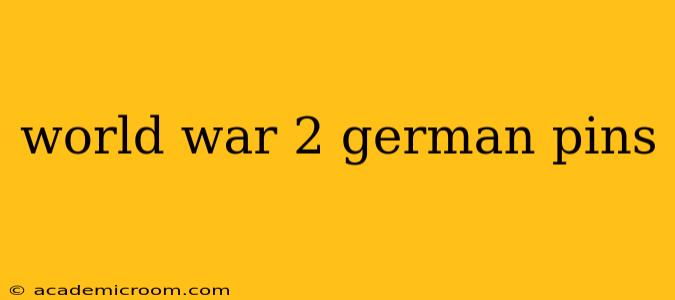World War II German pins offer a fascinating glimpse into the history, ideology, and everyday life of the Third Reich. These small objects, often overlooked, hold significant historical and collectible value, providing insights into propaganda, military organizations, and civilian life during this turbulent period. This guide explores the different types of WWII German pins, their historical context, and what collectors should consider when acquiring these items.
What Types of WWII German Pins Exist?
The range of WWII German pins is surprisingly diverse. They weren't just military; many were created for civilian organizations, political groups, and even commercial purposes. We can broadly categorize them as follows:
-
Military Pins: These pins often featured unit insignia, awards, or symbols representing branches of the Wehrmacht (army, navy, air force). Identifying the specific unit or award requires careful examination of the details and often expert knowledge. Some were authorized, others unofficial.
-
Political Pins: These pins prominently featured Nazi symbols like the swastika, the Parteiadler (party eagle), or portraits of Hitler. They were used by members of the Nazi Party (NSDAP) and affiliated organizations. Understanding the specific organization represented is crucial for historical context.
-
Civilian Pins: A broad category including pins associated with various civilian organizations, clubs, and even commercial businesses. These pins often reflect the prevailing social and political climate of the time. They can offer insights into daily life outside the military and political spheres.
-
Occupation Pins: Pins issued or created in territories occupied by Germany during the war often contain unique symbols or designs specific to those regions. These pins provide a unique perspective on the experiences of those under German occupation.
What Should Collectors Look for When Acquiring WWII German Pins?
The collecting of WWII German pins requires careful consideration and responsible acquisition. Here are some key points:
-
Authenticity: The market is rife with reproductions and fakes. Examine the pin meticulously for signs of wear consistent with age, correct materials, and accurate markings. Comparing it with known examples from reputable sources can help.
-
Provenance: Understanding the pin's history adds significantly to its value and importance. Documentation of its origin enhances its credibility.
-
Condition: The condition of the pin greatly impacts its value. Factors such as pin back, enamel condition, and overall wear contribute to its assessment.
-
Rarity: Some pins are far rarer than others, and their rarity directly impacts their value.
-
Ethical Considerations: It is crucial to consider the ethical implications of collecting such items. These pins are associated with a dark and violent period in history. Respectful handling and responsible acquisition are paramount.
Are WWII German Pins Valuable?
The value of WWII German pins varies enormously depending on factors like rarity, condition, authenticity, and historical significance. Some common pins might be worth only a few dollars, while exceptionally rare and well-preserved examples can fetch hundreds or even thousands of dollars at auction.
How Can I Identify a Fake WWII German Pin?
Identifying fake WWII German pins requires a keen eye and knowledge of authentic examples. Look for inconsistencies in the materials, markings, and overall construction. Poor-quality enamel, incorrect markings, or unusually bright colors are all potential signs of a fake.
Where Can I Find More Information on WWII German Pins?
Several books and online resources dedicated to military insignia and collectibles can provide further information. Online forums and communities dedicated to military history and collecting can be invaluable sources of information and expertise. Always consult reputable sources and experienced collectors when seeking authentication or information.
This guide provides a foundational understanding of World War II German pins. Remember responsible collecting practices and ethical considerations should always be paramount. The study and collection of these pins offer a potent, albeit sometimes disturbing, pathway to understanding a crucial period in history.
